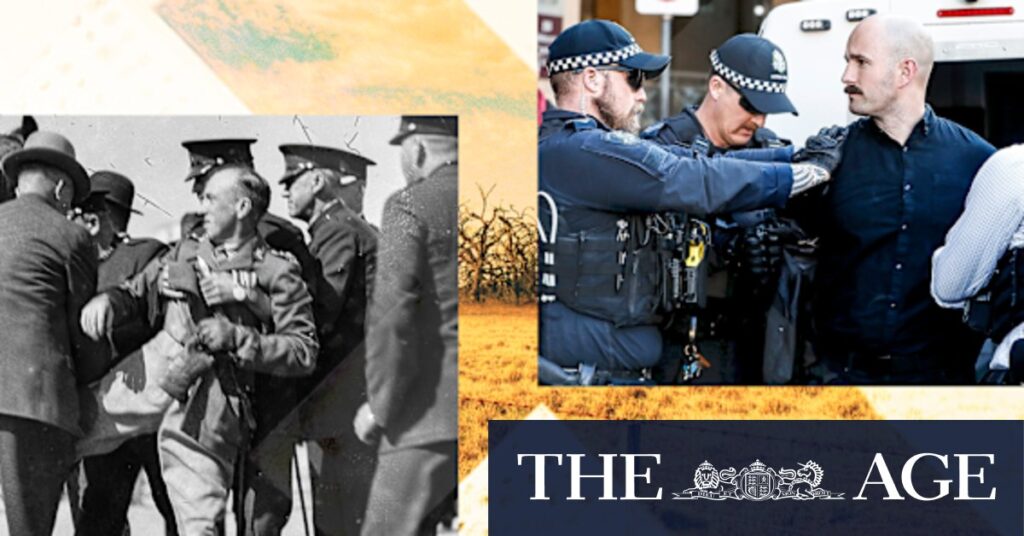
Panic spread across the Mallee’s flatlands around the small town of Ouyen in far north-west Victoria on the night of March 6, 1931. Wheat farmers, soldier settlers, and leading townsfolk armed themselves with guns and shovels, rushing to barricades in preparation for an imagined communist invasion. The Ouyen cell of the secret fascist White Army militia stood ready to defend the state of Victoria.
Word had spread through hushed phone calls that Sydney had fallen to a communist insurgency. Rumors claimed that Bolshevik forces, bolstered by Catholics and the unemployed, were gathering near Mildura, en route to Melbourne. This frenzied rumor machine set communities on edge, creating a situation so tense that it remains astonishing no one was killed.
The Rise and Fall of the White Army
Ouyen was one of more than a dozen towns across Victoria’s Mallee, Wimmera, Western, and Central Districts to witness the emergence of anti-communist, anti-Catholic militia cells. These cells were formed in such secrecy that many country wives were unaware of the White Army’s existence, let alone their husbands’ involvement. Historian Michael Cathcart analyzed this bizarre chapter in Australian history in his 1985 thesis, later published as the book Defending the National Tuckshop: Australia’s Secret Army Intrigue of 1931.
In the Wimmera town of Donald, Protestant militiamen were issued ammunition—500 rounds per man, according to one informant—in response to rumors that local Catholic figures were arming themselves. Meanwhile, Catholics gathered at the convent, preparing for an attack by Protestant militiamen. In Wedderburn, 225 kilometers down the Calder Highway from Ouyen, the local White Army cell stopped cars and threatened travelers unless they hoisted white flags. Two men even climbed gum trees to guard the town’s water reservoir, only to be forgotten for almost two days after their comrades stood down.
Fascism’s Underlying Threat
While recent weeks have seen neo-Nazi thugs marching through Melbourne’s streets, the 1930s saw tens of thousands quietly recruited by the White Army in Victoria and its allied fascist New Guard in New South Wales. As the Great Depression deepened, the White Army, also known as the League of National Security, was led by figures such as Thomas Blamey, the chief commissioner of the Victoria Police, and other senior military officers.
Blamey, who publicly admired Italy’s fascist dictator Benito Mussolini and spoke approvingly of the German National Socialist (Nazi) movement, later led Australian troops against Hitler’s and Mussolini’s forces during World War II. However, between the wars, his authoritarian tendencies led him to establish a covert paramilitary force ready to combat a perceived Bolshevik uprising.
Manufactured Enemies and Historical Parallels
Fascism thrives on enemies, real or imagined. Today’s neo-Nazis target immigrants, Indigenous Australians, and the political left. Anti-immigration sentiments have long fueled hatred in Australia, dating back to the gold rush era when Chinese miners faced violence. By the 1930s, the White Australia policy was so entrenched that few immigrants remained to incite fascist ire. Thus, threats were manufactured, with Catholics and the unemployed becoming convenient scapegoats.
Catholics, most of Irish descent, had opposed conscription during World War I and tended to vote Labor, making them natural allies of the Bolsheviks in the minds of the White Army’s boosters. This ignored the fact that Catholics and communists had little in common and often opposed each other.
The Depression-era unemployed were added to the mix as a handy threat. Despite the scarcity of actual communists in Australia, the fabricated vision of a treasonous alliance between Bolsheviks, Catholics, and the jobless made it easy to alarm the gullible and enlist “patriots” into Blamey’s clandestine army.
Lessons from History
It all began to unravel when it became clear that no Bolshevik revolution was imminent. World War II, which exposed the true horrors of fascism, extinguished the remnants of the White Army that hadn’t already succumbed to embarrassment. Yet, 94 years after that night of irrational panic, a new wave of alarm over “mass immigration” has enabled modern Australian fascists to align with “patriotic” Australians, allowing neo-Nazi elements to lead marches and spread their toxic ideology.
The more things change, the more they stay the same. As history shows, the dangers of manufactured threats and divisive rhetoric can have lasting impacts, making it crucial to remain vigilant against the resurgence of extremist ideologies.





